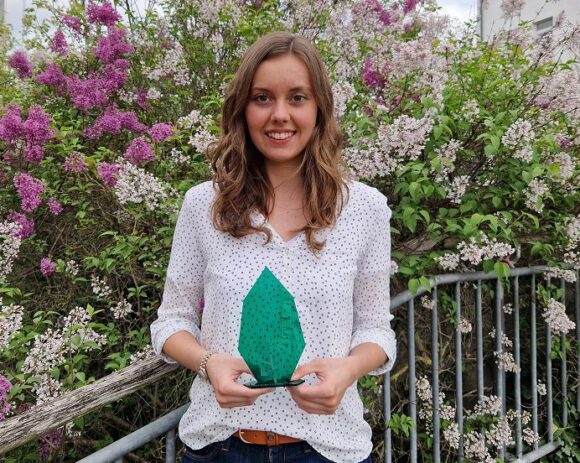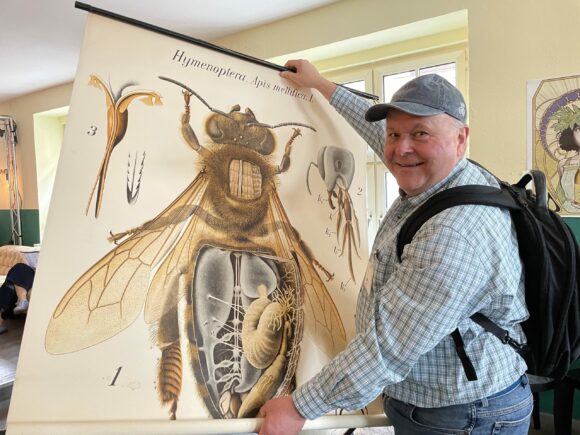Innovative research for industry, science and for sustainability in everyday life are core features of Hof University of Applied Sciences. For the second time, the Institute for Applied Biopolymer Research at Hof University of Applied Sciences (ibp) has now organized the symposium “Bioplastics – Scientific and industrial Trends” to make the latest developments in the field of bioplastics accessible to a wider audience. Thanks to the support of the European Social Fund (ESF), the Upper Franconia Foundation and the Society of Friends and Supporters of Hof University of Applied Sciences (Gesellschaft der Freunde und Förderer der Hochschule Hof e.V.), participation in the online conference was once again free of charge for the approximately 180 spectators. In addition to presentations from science and industry, a panel of experts addressed the question of the effective lifetime of biopolymers and their degradability in the environment. Awards were given for the best presentations and papers of the day.

The conference was opened by university president Prof. Dr. Dr. h.c.. Jürgen Lehmann and Prof. Dr. Michael Nase, head of the Institute for Applied Biopolymer Research at Hof University of Applied Sciences (ibp), and was masterfully accompanied by moderators Kübra Aslan and Lucas Großmann.
Which is better for bioplastics: beer or wine residues?
Already at the beginning of the conference, besides highly interesting contributions on synthesis, processing, application, recycling, composting as well as the degradation of bioplastics, another interesting topic emerged: Do residues from wine prove to be better for the enrichment of bioplastics than those from beer? In this regard, it is important to know: In most cases, such residual materials are first dried, ground and then added in powder form to the starting plastic during processing in order to obtain certain properties of the bioplastics. Not only President Dr. Dr. h.c. Jürgen Lehmann was clearly on the side of wine on this issue, since residual materials from beer have so far been regarded solely as fillers at the ibp for the production of bioplastics

From a total of 14 presentations, the conference participants also chose the one on the use of grape marc (press residues from grapes) in bioplastics as their favorite
One third of every grape remains unused in wine production and is not used for the actual wine. That’s why it’s not surprising that there are already attempts to integrate this byproduct as an additive in biopolymers.”
Benedikt Hiller, speaker
One particular advantage of wine residues: Wine pomace contains so-called flavonoids, substances that have antioxidant properties and can thus influence aging. These substances are also found, for example, in coffee, wine, green tea and apple peel, and are thus often considered in the vernacular to be beneficial to health. “This is also has an impact on the lifespan of bioplastics,” Hiller added. In addition, the previously unused grape waste could have a positive effect on the manufacturing costs of biopolymers.
Interactive participation by participants
The conference participants were also actively challenged during the panel discussion with experts Jöran Reske (INTERSEROH Dienstleistungs GmbH), Christian Eder (BBG Donau-Wald KU) and Nico Arbeck (C.A.R.M.E.N. e.V.): They were able to engage in lively discussions on the topics of “recycling”, “composting” and “use of bioplastic bags”. It became clear that there is still a need for more information on the correct use, recycling and composting of bioplastics.
The presentations provided an insight into current developments from industry and research on a wide range of topics from the world of bioplastics.”
Prof. Dr. Michael Nase, Institute Director ibp
The focus was on the additivation of bioplastics (including with wine grains), but also on the design of products with biopolymers and the life cycle of the corresponding bioplastic products. Likewise, other plenary presentations provided important insight into the development of biopolymers and the use of plastic recyclates in the automotive sector.
Instead of making a final decision between beer and wine, the awards ceremony at the end of “Bioplastics 2022” awarded Sit Hajar Othman with the prize for the best poster. The prize for the overall best presentation at the symposium went to Benjamin Rodriguez Hernandez. The latter dealt with the modification of the bioplastic PLA. The otherwise very brittle bioplastic could be made significantly more flexible by chemical modification. The modified material could be used to produce flexible films that could be used as a potential alternative to conventional PE films.

Next Bioplastics conference in spring 2024
The symposium “Bioplastics – Scientific and industrial Trends” is organized every two years by Hof University of Applied Sciences and will next take place in spring 2024.







